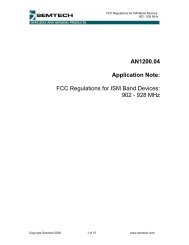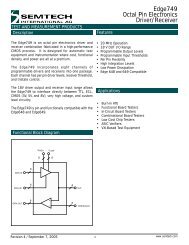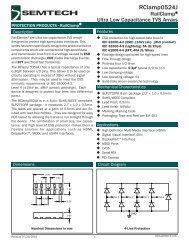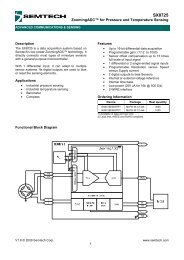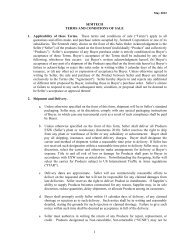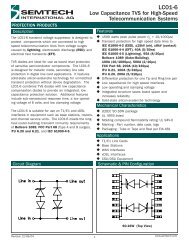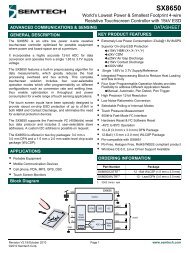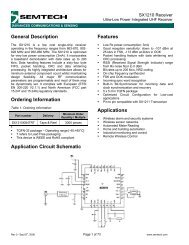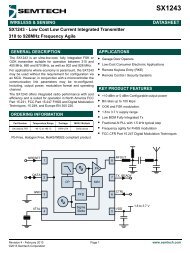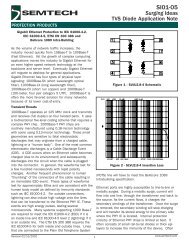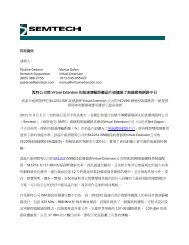PortDG0411 - Semtech
PortDG0411 - Semtech
PortDG0411 - Semtech
You also want an ePaper? Increase the reach of your titles
YUMPU automatically turns print PDFs into web optimized ePapers that Google loves.
Applications<br />
Portable Device Interfaces Protection<br />
IEC 61000-4-x Transient Immunity Standards<br />
The International Electrotechnical Commission (IEC), a worldwide<br />
organization promoting international cooperation on questions<br />
concerning standardization in electrical & electronic fields, has<br />
developed transient immunity standards which have become<br />
minimum requirements for manufacturers wanting to do business<br />
in the European Community (EC).<br />
Three of the IEC standards deal with transient immunity:<br />
• IEC 61000-4-2 : Electrostatic Discharge (ESD)<br />
• IEC 61000-4-4 : Electrical Fast Transient/Burst<br />
(Electrical Fast Transients)<br />
• IEC 61000-4-5 : Surge Immunity<br />
The ESD threat is divided into four threat levels. Threat level 1 is<br />
considered the least severe while threat level 4 is the most severe.<br />
Most manufacturers will adhere to level 4: ±8kV contact discharge,<br />
±15kV air discharge. IEC 61000-4-2 also specifies the ESD current<br />
waveform and parameters shown in Figure 1 & Table 1.<br />
I peak<br />
100%<br />
90%<br />
I at 30 ns<br />
I<br />
The following sections provide a summary of each of the transient<br />
immunity standards.<br />
IEC 61000-4-2 – Electrical Discharge (ESD)<br />
Standard<br />
I at 60 ns<br />
10%<br />
30 ns<br />
60 ns<br />
t<br />
IEC 61000-4-2 addresses one of the most common forms of transients<br />
in electronic systems: Electrostatic discharge (ESD). ESD results<br />
from conditions which allow the build up of electrical charge from<br />
contact and separation of two non-conductive materials. When<br />
the charged body is brought in proximity of another object of lower<br />
potential, energy is released in the form of electrostatic discharge.<br />
The standard defines immunity requirements for ESD which can<br />
be coupled into the equipment directly or through radiated effects.<br />
Direct coupling includes any user accessible entry points such<br />
as I/O ports, switches, computer keyboards, panel displays, and<br />
equipment housings. Radiated coupling results from the discharge<br />
between two bodies which are external to the system.<br />
Because the human body is one of the most common generators<br />
of ESD, the IEC standard defines a test set up which is designed<br />
to simulate an ESD event from a human body. The “Human<br />
Body Model” (HBM) as it is referred to, is considered a valid<br />
representation of worst case ESD stresses. Discharge into<br />
equipment may be through direct contact (contact discharge<br />
method) or just prior to contact (air discharge method). Contact<br />
discharge is the preferred test method, but air discharge is used<br />
where contact discharge cannot be applied.<br />
tr = 0.7 to 1 ns<br />
The rise time is extremely fast, defined as 0.7 to 1ns, with a second<br />
peak at 30ns and a total duration of only 60ns. The total energy<br />
contained within the pulse is approximately a few hundred<br />
microjoules.<br />
Transient Voltage Suppression (TVS) diodes are an ideal choice<br />
for meeting the ESD transient immunity requirements of IEC<br />
61000-4-2 and are proven solutions for suppressing system level<br />
ESD events. The extremely fast response time of the TVS diode<br />
is essential for responding to the 1ns rise time of the ESD pulse.<br />
Additionally, TVS diodes are capable of clamping the incoming<br />
transient to a low enough level as not to cause damage to the<br />
protected semiconductor. All TVS diode devices and families<br />
offered by <strong>Semtech</strong> may be used to suppress ESD to level 4 of IEC<br />
61000-4-2. The fast response and low clamping levels make TVS<br />
diodes suitable for ESD suppression on data and I/O ports.<br />
Level<br />
Indicated<br />
Voltage<br />
Figure 1 - ESD Waveform per IEC 61000-42<br />
First peak<br />
current of<br />
discharge<br />
+/- 10%<br />
Rise time<br />
(tr) with<br />
discharge<br />
switch<br />
Current<br />
(+/-<br />
30% at<br />
30 ns)<br />
Current<br />
(+/- 30%<br />
at 60 ns)<br />
kV A ns A A<br />
1 2 7.5 0.7 to 1 4 2<br />
2 4 15 0.7 to 1 8 4<br />
3 6 22.5 0.7 to 1 12 6<br />
4 8 30 0.7 to 1 16 8<br />
Table 1 – IEC61000-4-2 Waveform Parameters<br />
Protection Design Guide ©2011 Copyright <strong>Semtech</strong> Corporation. All rights reserved. All Clamp products are registered trademarks of <strong>Semtech</strong> Corporation. 25



